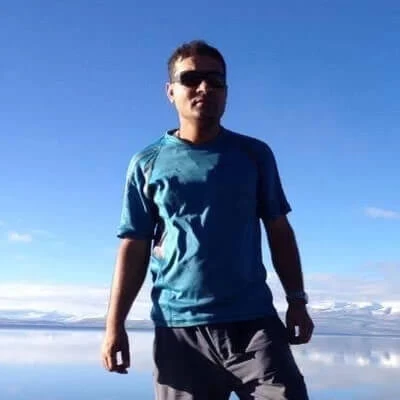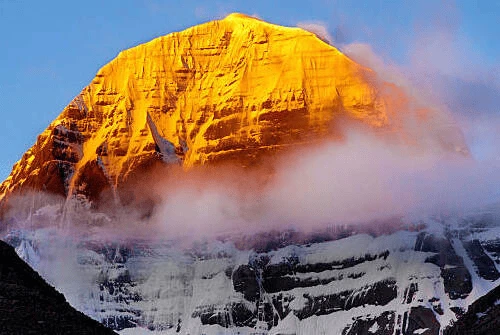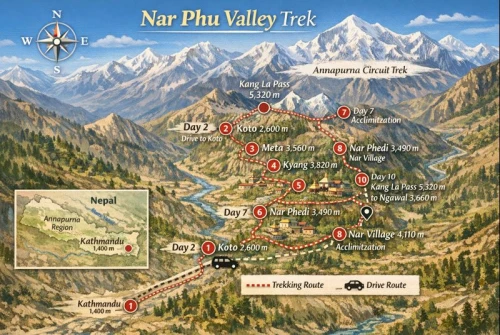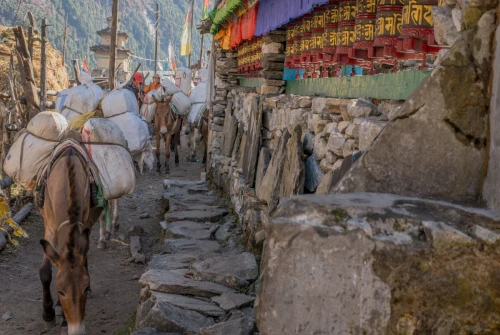Key Information about the Three Passes Trek:
- Unofficial Capital: Namche Bazaar
- Primary Language: Nepali
- Official Currency: Nepalese Rupee (NPR)
- Time Zone: NPT (UTC+05:45)
- Country Code: +977
- Legal Drinking Age: 18
- Public Drinking: Permitted
- Tap Water Suitability: Not potable
- Toilet Paper Disposal: Use designated bins
- Required Vaccinations: As recommended by the CDC
- Credit Card Usage: It's advisable to carry cash
- Tipping Etiquette: Not obligatory but appreciated
- Emergency Contact Number: 100
- Electrical Outlets: Type C / D / M (230 V / 50 Hz)
10 Things You Must Know Before Doing "Everest Three Pass Trek"
If the Everest Three Pass Trek is a part of your adventure aspirations, and you're gearing up for your inaugural trip, there's a wealth of information you should be aware of. To assist you in your preparations, we've put together a compilation of the essential ten factors you should be mindful of to guarantee a secure, pleasurable, and prosperous expedition on the Everest Three Pass Trek. Let's commence the process of getting you ready for this remarkable journey to the base of the world's tallest peak!
1. Best time to go on the Everest Three Passes Trek
The best time to embark on the Everest Three Passes Trek is during the pre-monsoon (spring) and post-monsoon (autumn) seasons, which offer favorable weather conditions and stunning landscapes. The two primary trekking seasons are:
Spring (April to May):
- Weather: Mild temperatures and clear skies.
- Scenery: Blooming rhododendrons and other wildflowers.
- Visibility: Excellent views of the surrounding peaks.
- Temperature: Gradually warming, especially at lower altitudes.
- Crowds: Relatively high, especially around popular viewpoints.
Autumn (October to November):
- Weather: Stable weather conditions with clear skies.
- Scenery: Lush landscapes with clear visibility.
- Temperature: Cool temperatures, especially at higher elevations.
- Crowds: Peak trekking season; expect more fellow trekkers.
During these seasons, the weather is generally more predictable, with minimal precipitation and comfortable temperatures. The trails are well-defined, and the risk of encountering heavy snowfall or extreme cold is lower compared to the winter months. Both spring and autumn offer an excellent balance between trekking conditions and the overall experience.
It's essential to be aware that while trekking during the winter months (December to February) is possible, it comes with colder temperatures, the possibility of snow-covered trails, and higher risks. Similarly, the monsoon season (June to September) brings heavy rainfall and is not recommended for trekking in the Everest region.
Ultimately, choosing the best time for the Everest Three Passes Trek depends on your preferences and tolerance for weather conditions, but spring and autumn are generally considered the optimal periods for this challenging and rewarding trek.
2. Insights into Altitude: Identifying Acute Mountain Sickness (AMS) during the Everest Three Pass Trek
Embarking on the Everest Three Pass Trek necessitates a comprehensive understanding of altitude-related challenges, particularly the recognition and management of Acute Mountain Sickness (AMS). As trekkers ascend through various altitude zones, ranging from lower elevations to formidable mountain passes, the risks associated with AMS become more pronounced.
AMS is a condition triggered by the reduced air pressure and lower oxygen levels encountered at higher altitudes. Common symptoms include headaches, nausea, dizziness, and fatigue. To mitigate the impact of AMS, strategic measures such as acclimatization, hydration, and careful monitoring of symptoms are crucial. Trekkers are advised to listen to their bodies, communicate any discomfort to guides or fellow trekkers, and, if necessary, take timely descent to lower altitudes. Understanding emergency evacuation procedures, maintaining physical fitness, and adhering to a gradual ascent are key components in ensuring a safe and fulfilling experience on the Everest Three Pass Trek. By prioritizing health and proactively managing altitude challenges, trekkers can navigate the journey with greater confidence and resilience.
3. An Additional Day for Acclimatization Days On the Everest Three Pass Trek
To improve trekkers' safety and well-being, it is strongly advised to include an additional day dedicated to acclimatization on the Everest Three Pass trip. Acclimatization is an important part of adjusting to higher elevations, allowing the body to adapt to the decreased oxygen levels found in hilly areas.
Participants can rest and adjust at a greater elevation by adding an extra acclimatization day to the trek plan. This purposeful pause helps to avoid the onset of Acute Mountain Sickness (AMS) and other altitude-related difficulties, resulting in a more comfortable and enjoyable trekking journey.
During this extra acclimatization day, trekkers can indulge in small activities like short walks or treks to help their bodies gradually acclimate. It also allows you to explore the neighboring surroundings and enjoy the spectacular sights without having to cross long distances.
Finally, spending an extra day to acclimation demonstrates a proactive attitude to altitude-related issues, prioritizing trekkers' health and safety on the Everest Three Pass Trek. Trekkers are encouraged to follow the advice of competent guides and stick to suggested acclimatization techniques during the route.
4. Essential Packing: Items to Bring on Your Everest Three-Pass Trek
When gearing up for the Everest Three Pass Trek, having the right essentials in your backpack is imperative. Here's a checklist of items to ensure you're well-prepared for this challenging adventure:
- Comfortable and Sturdy Backpack: A reliable backpack with sufficient capacity for your essentials.
- High-Quality Trekking Boots: Durable and comfortable trekking boots suitable for varied terrains.
- Water Purification System: Ensure access to safe drinking water with a reliable purification system.
- Navigation Tools: Carry a map, compass, and/or GPS device to navigate through the trekking routes.
- Layered Clothing: Pack clothing suitable for diverse weather conditions, including thermal layers, waterproof jackets, and moisture-wicking fabrics.
- Sleeping Bag: A quality sleeping bag suitable for colder temperatures encountered at higher altitudes.
- Trekking Poles: Provide stability and support during ascents and descents.
- Headlamp/Flashlight: Essential for visibility during early morning or late-night treks.
- Medical Kit: Include a comprehensive medical kit with first aid supplies and specific medications for altitude sickness, gastrointestinal issues, and common illnesses.
- Sun Protection: Sunscreen, sunglasses, and a wide-brimmed hat to shield against the strong mountain sun.
- Thermal Gloves and Hat: Protect against cold temperatures, especially at higher elevations.
- Snacks and Energy Bars: Carry lightweight, energy-rich snacks to fuel your trek.
- Trekking Permit and Identification: Ensure you have all necessary permits and carry identification.
- Camera/Smartphone: Capture the breathtaking scenery along the journey.
- Cash and Credit Cards: Have sufficient local currency and a credit card for emergency expenses.
5. Food During Everest Three Pass Trek
During the Everest Three Pass Trek, maintaining proper nutrition is crucial for sustaining energy levels and supporting your physical well-being. While on the trek, you'll have access to teahouses and lodges along the route, providing meals that cater to trekkers' dietary needs. Here's what you can expect in terms of food during the Three Passes Trek:
Teahouse Meals:
Teahouses along the trekking route offer a variety of meals, including Nepali, Tibetan, and international cuisine. You can expect meals like dal bhat (rice with lentil soup), noodles, rice, pasta, and vegetable or meat curries.
Breakfast:
- Typical breakfast options include eggs (boiled, fried, or omelets), porridge, muesli, pancakes, and Tibetan bread.
- Hot beverages such as tea and coffee are also readily available.
Lunch:
- Lunch options often consist of soups, sandwiches, momos (dumplings), and fried rice or noodles.
- Teahouses usually offer packed lunches for trekkers to carry during the day.
Dinner:
- Dinners are substantial and typically include a variety of dishes such as yak stew, pasta, pizza, and local specialties.
- Many teahouses offer a communal dining experience, fostering a sense of camaraderie among trekkers.
Snacks:
- It's advisable to carry some energy-boosting snacks such as nuts, granola bars, chocolates, and dried fruits for quick bites between meals and during the trek.
Hydration:
- Staying hydrated is essential at high altitudes. Teahouses provide hot drinks like tea and coffee, and you can also purchase bottled water or use water purification methods.
Special Dietary Requirements:
- Teahouses are generally accommodating to dietary preferences and restrictions. It's advisable to communicate any special requirements in advance.
While the food offerings along the trek are diverse, it's essential to note that menu options may become more limited at higher elevations. Additionally, it's a good idea to carry some personal snacks to supplement your energy intake, especially during more challenging parts of the trek. Overall, enjoying the local cuisine and embracing the teahouse experience are integral aspects of the Everest Three Pass Trek.
6. Prioritizing Safety: Choosing a Trustworthy Trekking Company for the Everest Three Pass Trek.
Ensuring a safe and gratifying experience on the Everest Three Pass Trek begins with the critical decision of selecting a trustworthy trekking company. Prioritizing safety considerations is paramount in this challenging expedition. To make an informed choice:
Commence by assessing the company's reputation and experience, relying on reviews and testimonials from past trekkers to gauge their performance. Verify that the trekking company is licensed and certified by local authorities, ensuring compliance with safety standards. Evaluate the safety record of the company, as a positive track record reflects a commitment to the well-being of trekkers.
Emphasize the importance of knowledgeable guides who possess experience, qualifications, and expertise in dealing with altitude-related challenges. Seek comprehensive services that cover transportation, accommodation, permits, and an emergency evacuation plan. Confirm the insurance coverage for both trekkers and the company, especially in emergencies. Opt for smaller group sizes to ensure individual attention and a more personalized experience. Assess the communication and support systems, ensuring clarity in pre-trek briefings and availability of emergency communication during the trek.
Consider a trekking company's environmental and social responsibility practices, emphasizing a commitment to sustainability. Ensure flexibility and contingency plans, as a reliable company adapts to changing circumstances and unforeseen challenges. By meticulously evaluating these factors, trekkers can confidently choose a company that places safety at the forefront, laying the foundation for a secure and memorable Everest Three Pass Trek. Effective communication and adherence to the company's guidance throughout the journey further contribute to a successful trekking experience.
7. Three Passes Trek Route Details
Trail Information: The route for the Three Passes Trek is clearly marked and easily navigable. The vastness of the mountains makes navigation different from densely forested areas. The terrain mostly involves walking across valleys with limited options for deviation. Getting a map in Kathmandu can be helpful for major junctions, especially if you find yourself without local guidance. For more insights into the Three Passes Trek route, refer to this article.
Passes Overview: The trek involves three major passes - Kongma La (18,209 ft / 5,550 m), Cho La (17,782 ft / 5,420 m), and Renjo La (17,560 ft / 5,360 m). Kongma La is generally considered the most challenging due to its length, Cho La involves crossing a glacier (microspikes recommended), and Renjo La is often perceived as the easiest. However, conditions can vary based on weather, making it crucial to start early each day to allow ample time and avoid adverse afternoon weather conditions.
Everest Base Camp: If detouring to Everest Base Camp or Kala Patthar interests you, it's entirely feasible. The first village west of Kongma La (second east of Cho La) allows for a day trip to Everest Base Camp via Gorak Shep. For those interested in Kala Patthar, it can be included either in a long day back to Lobuche or by staying overnight in Gorak Shep.
Hiking from Jiri: Opting to travel by bus or jeep to Jiri (or Shivalaya) and then hiking to Lukla presents a challenging and less crowded alternative compared to the trail above Lukla, where most trekkers begin. If time is a constraint, taking transport to Salleri or Phaplu, which is approximately two days away from Jiri, can be a time-saving option.
Considerations on Turning Around: Despite prevalent concerns and warnings about the passes being closed due to snow or other reasons, it's advisable to assess the conditions firsthand. Fear should not deter trekkers; instead, an early start allows for a firsthand evaluation. If the trail, pass, or weather appears challenging beyond one's experience level, there's no harm in turning around. In practical terms, the passes are not far from the nearest villages, emphasizing the importance of personal judgment and flexibility during the trek.
8. Estimating the Budget for the Everest Three Passes Trek
The overall cost of undertaking the Everest Three Passes Trek is subject to variations based on factors like the chosen trekking season, the duration of the trek, the preferred level of comfort, and the size of the trekking group. Below are key considerations for budgeting:
Trekking Permits:
- Two essential permits are required: the Sagarmatha National Park Permit and the Khumbu Rural Municipality Permit.
- The combined cost for both permits is approximately $50 USD.
Guide and Porter Fees:
- If opting for a guide or porter, consider their daily fees.
- Guide fees typically range from $20 to $150 USD per day, while porter fees vary from $25 to $35 USD per day.
Accommodation:
- Accommodation options include teahouses and lodges with varying amenities.
- Costs for accommodation can span from $10 to $300 USD per night.
Food and Water:
- Budget for meals, with costs ranging from $7 to $15 USD per meal.
- Additionally, factor in expenses for bottled water or water purification tablets, as local water is not potable.
Equipment and Gear:
- If lacking personal trekking gear, consider the cost of renting or purchasing items like a sleeping bag, down jacket, trekking boots, and a backpack.
- Rental or purchase expenses for equipment can fall between $50 and $400 USD.
Transportation:
- The mode of transportation to and from the trek's starting point affects costs.
- A flight from Kathmandu to Lukla, the trek's initiation point, typically ranges from $170 to $200 USD each way.
9. Mental Preparation on Everest Three Passes Trek
Embarking on the Everest Three Passes Trek necessitates a robust mental preparedness, complementing the physical demands of the journey. In the dynamic Himalayan terrain, cultivating a mindset that welcomes uncertainty becomes paramount. This trek unfolds in an ever-changing environment, demanding adaptability and a positive outlook. Challenges are inevitable, yet they present opportunities for personal growth and triumph. Resilience becomes a cornerstone in facing unpredictable weather and challenging conditions.
Patience and self-awareness are vital as the trek spans multiple days, requiring a mindful pace and acknowledgment of individual progress. Flexibility in adapting to varying altitudes and unexpected obstacles is essential, as is the power of visualization to instill confidence. Social bonds within the trekking group offer crucial mental support, creating a collective spirit to overcome challenges.
Acknowledging the mind-body connection emphasizes the importance of a healthy physical state for mental resilience. Practicing gratitude enhances the overall experience, fostering positivity amidst the grandeur of the Himalayas. Ultimately, the Everest Three Passes Trek is not just a physical feat but a transformative journey of self-discovery, where each step becomes an opportunity for learning and evolution.
10. Insider Tips for the Everest Three Passes Trek
Embracing Winter: Contrary to expectations, winter is an optimal time to explore the Himalayas. Despite its intimidating reputation, the winter months offer clear skies and minimal precipitation. While the region can get chilly, packing an extra base layer ensures comfort. Having visited twice in winter and once in spring, I can attest to the unique beauty and tranquility this season brings to the trek.
Connectivity Challenges Above Namche Bazaar: Wi-Fi is available in the Himalayas, but it comes with limitations. Beyond Namche Bazaar, free Wi-Fi becomes scarce, and accessing it often requires purchasing cards from lodges with passcodes for the "EVEREST LINK" network. These cards, sold in various denominations, can cost up to 1,000 NPR (~$10 US) for 24 hours. Availability may vary, and some lodges may sell them at different prices. Keep in mind that electricity, and consequently Wi-Fi, may be turned off after a certain time in many lodges.
Navigating the Lukla Flight Adventure: Consider starting your trek from Jiri for a more immersive experience, but if time is a constraint, a flight to Lukla becomes a practical option. While often dubbed "the most dangerous flight in the world," it's crucial to separate fact from sensationalism. Although the flight has its thrills, it's far from a perilous journey. The cost for the flight to Lukla is around $150 each way. For more information on the Lukla flight, check here.
Financial Considerations – ATMs and Cash: ATMs are available in the Everest Region, with one in Lukla and two in Namche Bazaar. However, their reliability is not guaranteed. To avoid inconveniences, it's advisable to bring sufficient cash from Kathmandu. The majority of establishments do not accept cards, and while some places in Namche Bazaar may take cards, cash remains the preferred mode of payment above Namche. Plan ahead to ensure you have ample funds for both the ascent and descent.
These practical insights aim to enhance your preparation and enjoyment during the Everest Three Passes Trek, offering guidance on seasonal considerations, connectivity challenges, transportation choices, and financial preparedness.
Conclusion
In conclusion, the Everest Three Pass Trek stands as the ultimate challenge for those seeking an unparalleled adventure and a test of both physical and mental fortitude. The dynamic Himalayan landscape, characterized by unpredictable weather and ever-changing conditions, demands a level of adaptability and resilience that sets this trek apart. Embracing the unknown becomes a mindset, creating opportunities for personal growth and triumph in the face of challenges.
The trek's significance lies not only in conquering high-altitude passes but also in navigating a transformative journey of self-discovery. The need for mental preparedness becomes as crucial as physical readiness, requiring trekkers to maintain a positive outlook, practice patience, and visualize success in the midst of breathtaking yet challenging surroundings.
As trekkers traverse the diverse terrains, build social connections within their group, and cultivate gratitude for the privilege of experiencing the grandeur of the Himalayas, the Everest Three Pass Trek becomes more than a physical accomplishment. It becomes a profound exploration of one's capabilities, resilience, and the limitless potential for growth. In every step taken, this trek offers an extraordinary adventure, making it the ultimate challenge for those seeking an unparalleled and transformative journey.




